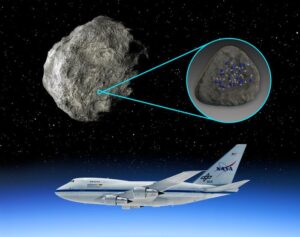
Water is kind of common in our solar system. We see it in craters on the Moon, at the poles of Mars, Earth has water in all its phases, and as we look toward the outer solar system, there are icy objects galore.
We know that earlier in our solar system, the Sun was hotter, misbehaved, and generally blasted water out of the inner solar system. The water we see here on Earth and other inner objects had to be brought to us after the Sun, very literally, cooled off. Where that water is one of the most interesting questions planetary scientists are working to solve.
A new paper in The Planetary Science Journal with first author Anicia Arredondo may have an interesting answer.
Using data from the now-retired SOFIA airborne observatory, researchers looked at a series of asteroids to see if they could find water ice using the same techniques used to find water ice on the moon with SOFIA, and they did. On the silicate-rich asteroids Iris, Melpomene, and Massalia, they found hydrated minerals, and on Iris and Massalia, they found the unambiguous signature of molecular water. This indicates that impacting asteroids could have brought water to our world in the past. Which we suspected, but now we know with more certainty.
